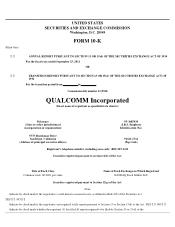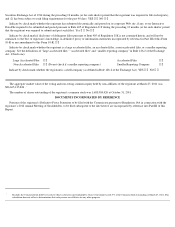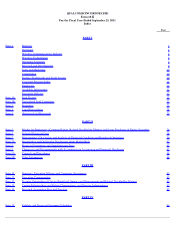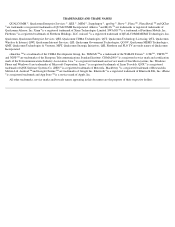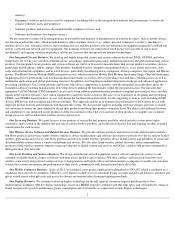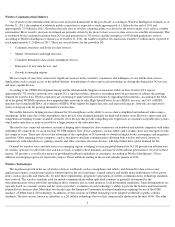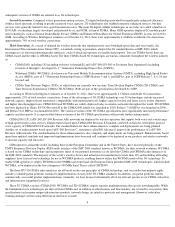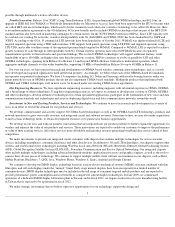Qualcomm 2011 Annual Report Download - page 11
Download and view the complete annual report
Please find page 11 of the 2011 Qualcomm annual report below. You can navigate through the pages in the report by either clicking on the pages listed below, or by using the keyword search tool below to find specific information within the annual report.
introduction of new products and services and/or possess unique capabilities or technology. To the extent that such investments become liquid
and meet our strategic objectives, we intend to make regular periodic sales of our interests in these investments that are recognized in investment
income.
Operating Segments
Consolidated revenues from international customers and licensees as a percentage of total revenues were 94%, 95% and 94% in fiscal 2011 ,
2010 and 2009 , respectively. During fiscal 2011 , 32%, 19%, 17% and 8% of our revenues were from customers and licensees based in China,
South Korea, Taiwan and Japan, respectively, as compared to 29%, 27%, 12% and 9% during fiscal 2010 , respectively, and 23%, 35%, 8% and
11% during fiscal 2009 , respectively. Revenues from Samsung Electronics constituted a significant portion (more than 10%) of consolidated
revenues in fiscal 2011 , 2010 and 2009 , and revenues from HTC also constituted a significant portion (more than 10%) of consolidated
revenues in fiscal 2011 .
Qualcomm CDMA Technologies Segment (QCT). QCT is a leading developer and supplier of integrated circuits and system software based
on CDMA, OFDMA and other technologies for use in voice and data communications, networking, application processing, multimedia functions
and global positioning system products. QCT’s integrated circuit products and system software are sold to or licensed to manufacturers that use
our products in wireless devices, particularly mobile phones, tablets, laptops, data modules, handheld wireless computers and gaming devices,
access points and routers, data cards and infrastructure equipment, and in wired devices, particularly broadband gateway equipment, desktop
computers, televisions and Blu-ray players. The MSM integrated circuits, which include the Mobile Data Modem, Qualcomm Single Chip and
Qualcomm Snapdragon devices, perform the core baseband modem functionality in wireless devices providing voice and data communications,
as well as multimedia applications and global positioning functions. In addition, our Snapdragon enabled integrated circuits provide advanced
application processing capabilities. QCT’s system software enables the other device components to interface with the integrated circuit products
and is the foundation software enabling manufacturers to develop devices utilizing the functionality within the integrated circuits. In fiscal 2011
,
QCT shipped approximately 483 million MSM integrated circuits for wireless devices worldwide as compared to approximately 399 million and
317 million in fiscal 2010 and 2009 , respectively. QCT revenues comprised 59%, 61% and 59% of total consolidated revenues in fiscal 2011 ,
2010 and 2009 , respectively.
QCT utilizes a fabless production business model, which means that we do not own or operate foundries for the production of silicon wafers
from which our integrated circuits are made. Integrated circuits are die, cut from silicon wafers, that have been assembled into packages or
modules and have completed the final test manufacturing processes. Die cut from silicon wafers are the essential components of all of our
integrated circuits and a significant portion of the total integrated circuit cost. We employ both turnkey and two-stage manufacturing business
models to purchase our integrated circuits. Turnkey is when our foundry suppliers are responsible for delivering fully assembled and tested
integrated circuits. Under the two-stage manufacturing business model, we purchase wafers and die from semiconductor manufacturing
foundries and contract with separate third-party manufacturers for probe, assembly and final test services. We refer to this two-stage
manufacturing business model as Integrated Fabless Manufacturing (IFM).
We rely on independent third-party suppliers to perform the manufacturing and assembly, and most of the testing, of our integrated circuits
based primarily on our proprietary designs and test programs. Our suppliers are also responsible for the procurement of most of the raw materials
used in the production of our integrated circuits. The primary foundry suppliers for our various digital, analog/mixed-signal, RF and PM
integrated circuits are Freescale Semiconductor, Globalfoundries, IBM, Samsung Electronics, Semiconductor Manufacturing International,
Taiwan Semiconductor Manufacturing, Tower Semiconductor and United Microelectronics. The primary semiconductor assembly and test
suppliers under our IFM model are Advanced Semiconductor Engineering, Amkor Technology, Siliconware Precision Industries and
STATSChipPAC. The majority of our foundry and subcontract assembly and test suppliers are located in the Asia-Pacific region.
QCT offers a broad portfolio of products, including both wireless device and infrastructure integrated circuits, in support of CDMA2000 1X
and 1xEV-DO, as well as the EV-DO Revision A/B evolutions of CDMA 2000 technology. Leveraging our expertise in CDMA, we also
developed and offer integrated circuits supporting the WCDMA version of 3G for manufacturers of wireless devices. More than 70 device
manufacturers have selected our WCDMA products that support GSM/GPRS, WCDMA, HSDPA (High-Speed Downlink Packet Access),
HSUPA (High-Speed Uplink Packet Access) and HSPA+ for their devices. QCT also sells multimode products for the LTE standard, which
offer seamless backward compatibility to existing 3G technologies.
Our integrated circuit products span a broad range of products, from entry-level products for emerging regions up to very high-end devices.
Our chipsets integrate unique combinations of features, such as multi-megapixel cameras, videotelephony, streaming multimedia, audio, 3D
graphics, advanced position-location capabilities through integrated gpsOne technology and peripheral connectivity, to enable a wide range of
devices.
Our gpsOne position location technology is in more than 700 million gpsOne enabled devices sold worldwide. Compatible
6


